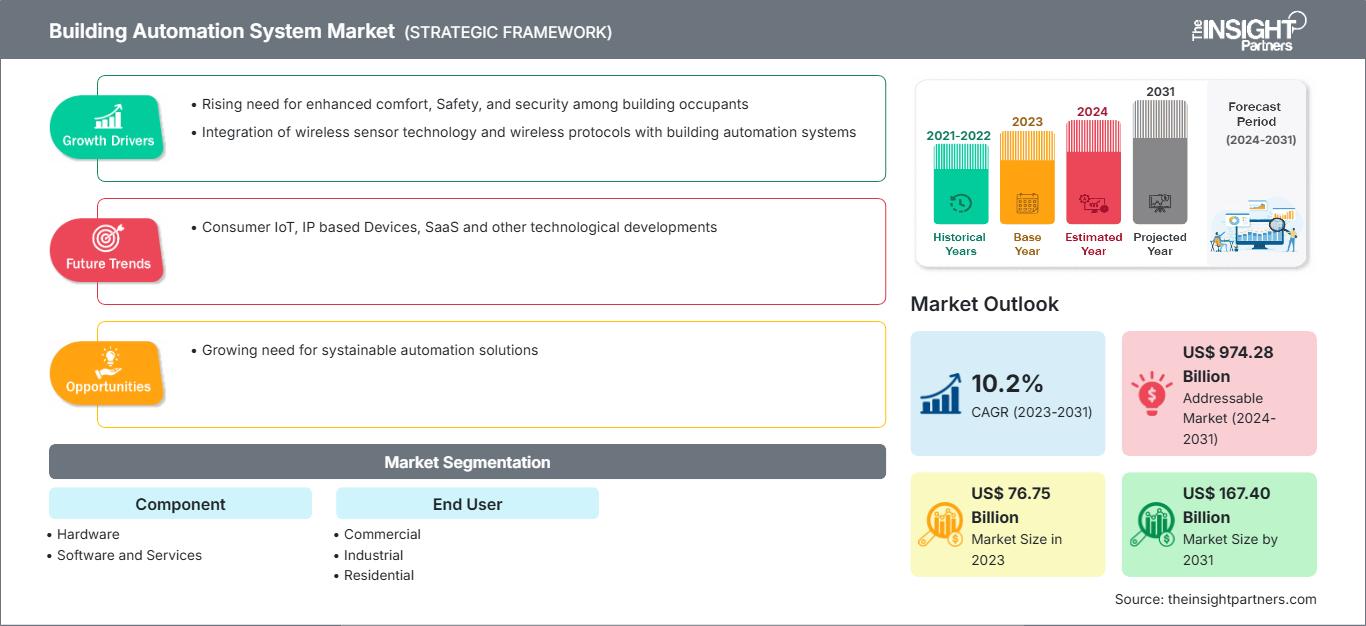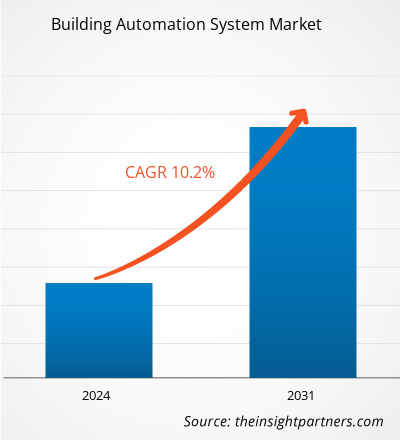빌딩 자동화 시스템 시장 규모는 2023년 767억 5천만 달러에서 2031년 1,674억 달러로 성장할 것으로 예상됩니다. 2023년부터 2031년까지 연평균 성장률 10.2%를 기록할 것으로 예상됩니다. 소비자용 IoT, IP 기반 기기, SaaS 및 기타 기술 개발이 시장의 주요 트렌드로 자리 잡을 것으로 예상됩니다.
빌딩 자동화 시스템 시장 분석
전 세계적으로 증가하는 건설 활동과 스마트 빌딩에 대한 수요 증가가 시장 성장을 촉진하는 주요 요인입니다. 빌딩 자동화 시스템은 정교한 센서, 액추에이터 및 네트워킹 기술을 사용하여 HVAC, 조명, 보안, 출입 통제 및 에너지 관리와 같은 빌딩 시스템을 중앙에서 제어하고 모니터링합니다. 이러한 기술은 빌딩 효율성을 극대화하고, 에너지 사용량을 줄이며, 시설 관리 절차를 간소화하고, 규정 및 표준을 준수하도록 설계되어 빌딩 자동화 시스템 시장에서의 수요를 더욱 증가시키고 있습니다. 사물인터넷(IoT), IP 기반 기기, SaaS, 머신러닝 및 기타 기술의 통합과 같은 떠오르는 기술 발전은 향후 몇 년 동안 새로운 트렌드를 가져올 것으로 예상됩니다.
빌딩 자동화 시스템 시장 개요
빌딩 자동화 시스템(BAS)은 운영자가 단일 인터페이스를 통해 연결된 모든 빌딩 시스템에 접근, 제어 및 모니터링할 수 있도록 합니다. BAS 기술을 통해 소유주는 네트워크로 연결된 전자 장치를 사용하여 빌딩 운영을 중앙에서 관리할 수 있습니다. 시스템은 거주자의 쾌적함을 유지하기 위해 환기, 습도, 조명 및 온도를 제어합니다. 재실 센서와 스케줄링 기능은 사용하지 않을 때 환경 시스템을 조정하여 에너지 낭비를 최소화합니다. 또한 모든 시스템이 최적의 효율과 정확성으로 작동하도록 보장합니다. 예방적 유지 보수가 필요할 때 센서를 통해 운영자에게 알림이 전송됩니다. 건물의 화재, 출입 및 감시 시스템은 모두 통합되어 빌딩과 거주자의 안전을 보호합니다.
요구 사항에 맞게 이 보고서를 사용자 정의하십시오.
이 보고서의 일부, 국가 수준 분석, Excel 데이터 팩을 포함하여 모든 보고서에 대한 사용자 정의를 무료로 받을 수 있을 뿐만 아니라 스타트업 및 대학을 위한 훌륭한 제안 및 할인을 이용할 수 있습니다
빌딩 자동화 시스템 시장: 전략적 통찰력

-
이 보고서의 주요 주요 시장 동향을 확인하세요.이 무료 샘플에는 시장 동향부터 추정 및 예측에 이르기까지 데이터 분석이 포함됩니다.
건물 자동화 시스템 시장 성장 동력 및 기회
향상된 편의성, 안전 및 보안에 대한 요구 증가
건물 자동화 시스템은 최첨단 장비와 기술을 제공하여 건물의 보안 시스템을 개선합니다. 건물 거주자에게 더 나은 보안을 제공하고 자산, 기업 자원, 재산 및 IT 데이터를 보호하는 데 도움이 됩니다. 재산 피해 및 도난을 방지하는 것 외에도, 이 시스템은 직원의 무단 침입 및 도난을 방지할 수 있습니다. 건물의 엘리베이터 출입 통제 시스템은 관리 직원이 제한 구역으로 지정한 건물 내 특정 층 및 구역으로의 출입을 제한합니다. 또한, 이 시스템은 보안 침해를 방지하고 시설 내 임시 교통 흐름을 허용합니다. 출입 통제 관리에서 시간 및 요일별 스케줄링 제약을 사용하여 허가받은 직원만 출입할 수 있습니다. 또한, 부지 내 및 건물 내에서 발생하는 모든 활동은 출입 통제 소프트웨어를 통해 기록 및 저장됩니다. 또한, 이 시스템은 가스 누출이나 화재와 같은 안전 문제를 감지하고 이러한 위험을 제한하기 위한 적절한 조치를 취하도록 프로그래밍할 수 있습니다.
지속 가능한 빌딩 자동화 솔루션에 대한 수요 증가
지속 가능한 빌딩은 에너지 소비와 탄소 배출을 최소화하는 것을 목표로 합니다. BAS는 재실 현황 및 환경 조건에 따라 HVAC, 조명 및 기타 시스템을 모니터링, 제어 및 최적화할 수 있습니다. 태양광 및 풍력과 같은 재생 에너지원으로의 전환이 증가함에 따라, BAS는 빌딩 운영 내에서 이러한 에너지원의 통합 및 활용을 지능적으로 관리하여 최적의 에너지 사용과 상당한 비용 절감을 보장합니다. BAS는 에너지 사용량 및 환경 지표에 대한 실시간 데이터를 제공하여 에너지 절약 전략 수립 및 지속 가능성 표준 및 규정 준수를 위한 정보에 기반한 의사 결정을 지원합니다. 지속 가능한 빌딩은 거주자의 편안함과 건강을 최우선으로 생각합니다. BAS는 실내 공기질 유지, 온도 조절, 자연 채광 최적화를 통해 거주자 만족도와 생산성 향상에 기여합니다. 또한, 지속 가능한 BAS 솔루션은 에너지 비용 절감, 유지 보수 필요성 감소, 장비 수명 연장을 통해 비용 절감 효과를 제공하여 건물 소유주와 운영자에게 경제적으로 매력적인 선택입니다. 지속 가능한 솔루션은 전 세계적인 지속 가능성 목표에 부합하며, 에너지 효율을 개선하고, 입주자의 편의성을 향상시키며, 건물 소유주와 운영자에게 상당한 경제적 이익을 제공합니다. 따라서 산업 전반에 걸쳐 지속 가능한 빌딩 자동화 솔루션에 대한 수요가 증가함에 따라 예측 기간 동안 빌딩 자동화 시장 성장에 상당한 기회가 창출될 것으로 예상됩니다.
빌딩 자동화 시스템 시장 보고서 세분화 분석
빌딩 자동화 시스템 시장 분석 도출에 기여한 주요 부문은 구성 요소와 최종 사용자입니다.
- 구성 요소를 기준으로 시장은 하드웨어, 소프트웨어, 서비스로 세분화됩니다. 하드웨어 부문은 2023년에 더 큰 시장 점유율을 기록했습니다. 빌딩 자동화 하드웨어는 센서와 제어 장치를 사용하여 건물의 공공 서비스(전기, 냉난방, 상하수도)를 모니터링하고 조정합니다. 빌딩 자동화 시스템의 하드웨어 구성 요소에는 온도 조절기(실내 온도 제어), 재실 센서(조명 제어), 습도 센서, 화재 및 연기 감지기, 보안 및 감시 시스템이 포함됩니다. 하드웨어 부문 시장은 보안 및 감시 시스템, 시설 관리 시스템, 방화 시스템 등으로 세분화됩니다. 빌딩 자동화 하드웨어를 제공하는 다양한 회사로는 Bosch Sicherheitssysteme GmbH, Lutron Electronics Co. Inc, Trane 등이 있습니다. 최종 사용자를 기준으로 시장은 상업용, 산업용, 주거용으로 구분됩니다. 2023년에는 상업용 부문이 시장을 장악했습니다. 상업용 건물에서는 BAS(빌딩 자동화 시스템)가 재실, 계절 또는 기타 주요 요인에 따라 내부 온도와 조명을 관리하기 위해 구현됩니다. 빌딩 제어 시스템은 냉난방 장비와 조명 시스템의 작동을 조절하여 시설에 배치된 인력의 생산성을 높이는 동시에 특정 구역이 사용되지 않을 때 에너지를 절약할 수 있도록 쾌적한 환경을 유지합니다. 또한, 상업용 BAS를 사용하면 유지보수 및 관리 직원에게도 유익한 것으로 입증되었습니다. 시스템 및 구성 요소 성능이 정기적으로 모니터링되므로 이상 감지 시 팀에 알림이 전송됩니다.
지역별 빌딩 자동화 시스템 시장 점유율 분석
빌딩 자동화 시스템 시장 보고서의 지리적 범위는 주로 북미, 아시아 태평양, 유럽, 중동 및 아프리카, 중남미의 5개 지역으로 나뉩니다.
북미는 2023년 빌딩 자동화 시스템 시장에서 가장 큰 점유율을 차지했으며, 그 뒤를 이어 유럽과 아시아 태평양 지역이 뒤따랐습니다. 북미 시장은 이 지역의 건설 활동 증가와 여러 주의 경제 성장으로 인해 예측 기간 동안 성장할 것으로 예상됩니다. 빌딩 자동화 시스템은 에너지 효율을 달성하는 데 널리 사용되는데, 이는 비용 절감과 직접적인 관련이 있기 때문입니다. 미국과 캐나다와 같은 국가들은 빠른 속도로 스마트 시티를 건설하고 있으며, 이는 예측 기간 동안 빌딩 자동화 시스템 시장 성장의 기회를 제공할 것으로 예상됩니다.
유럽의 건설 산업은 주로 신축 건설을 중심으로 엄청난 성장을 경험했으며, 이는 이 지역의 빌딩 자동화 시스템 시장을 강화할 것으로 예상됩니다. 유럽 건설 산업은 경제에서 중요한 역할을 하며, 약 1,800만 명의 고용을 창출하고 유럽 연합 전체 GDP의 9%를 차지합니다. 건설 산업은 새로운 주거, 산업 및 상업 시설 건설, 인프라 구축, 노후된 구조물 및 건물의 유지 보수에 중점을 두고 있습니다. 유럽 여러 국가의 정부들이 다양한 주요 건설 프로젝트 착수에 점점 더 적극적으로 참여하고 있으며, 이는 향후 유럽 연합의 빌딩 자동화 시스템 도입을 촉진할 것으로 예상됩니다.
빌딩 자동화 시스템
건물 자동화 시스템 시장 지역별 통찰력
The Insight Partners의 분석가들은 예측 기간 동안 빌딩 자동화 시스템 시장에 영향을 미치는 지역별 동향과 요인들을 면밀히 분석했습니다. 이 섹션에서는 북미, 유럽, 아시아 태평양, 중동 및 아프리카, 그리고 중남미 지역의 빌딩 자동화 시스템 시장 부문 및 지역별 현황도 살펴봅니다.
빌딩 자동화 시스템 시장 보고서 범위
| 보고서 속성 | 세부 |
|---|---|
| 시장 규모 2023 | US$ 76.75 Billion |
| 시장규모별 2031 | US$ 167.40 Billion |
| 글로벌 CAGR (2023 - 2031) | 10.2% |
| 이전 데이터 | 2021-2022 |
| 예측 기간 | 2024-2031 |
| 다루는 세그먼트 |
By 구성 요소
|
| 포함된 지역 및 국가 |
북미
|
| 시장 선도 기업 및 주요 회사 프로필 |
|
빌딩 자동화 시스템 시장 참여자 밀도: 비즈니스 역학에 미치는 영향 이해
건물 자동화 시스템 시장은 소비자 선호도 변화, 기술 발전, 그리고 제품 이점에 대한 인식 제고 등의 요인으로 인한 최종 사용자 수요 증가에 힘입어 빠르게 성장하고 있습니다. 수요가 증가함에 따라 기업들은 제품 및 서비스 확장, 소비자 니즈 충족을 위한 혁신, 그리고 새로운 트렌드를 적극 활용하고 있으며, 이는 시장 성장을 더욱 가속화하고 있습니다.

- 을 얻으세요 빌딩 자동화 시스템 시장 주요 주요 플레이어 개요
빌딩 자동화 시스템 시장 뉴스 및 최근 동향
빌딩 자동화 시스템 시장은 1차 및 2차 조사 후 주요 기업 간행물, 협회 데이터, 데이터베이스 등 정성적 및 정량적 데이터를 수집하여 평가합니다. 빌딩 자동화 시스템 시장의 몇 가지 동향은 다음과 같습니다.
- Honeywell과 Analog Devices, Inc.는 CES 2024에서 기존 배선을 교체하지 않고 디지털 연결 기술로 업그레이드하여 상업용 건물의 디지털화를 모색하기 위한 양해각서(MOU)를 체결했다고 발표했습니다. 이를 통해 비용, 낭비, 가동 중단 시간을 줄일 수 있습니다. 이 전략적 제휴를 통해 이 새로운 기술이 빌딩 관리 시스템에 최초로 적용될 것입니다.
(출처: Honeywell International Inc., 보도자료, 2024년 1월)
- Siemens Smart Infrastructure는 중소 규모 건물 관리를 위해 설계된 개방형의 사용하기 쉬운 IoT 솔루션인 Connect Box를 출시했습니다. Siemens Xcelerator 포트폴리오에 새롭게 추가된 Connect Box는 사용자 친화적인 건물 성능 모니터링 솔루션으로, 에너지 효율을 최대 30%까지 최적화하고 학교, 소매점, 아파트, 소규모 사무실 등 중소 규모 건물의 실내 공기질을 크게 개선할 수 있는 잠재력을 갖추고 있습니다. Siemens Xcelerator는 고객이 디지털 혁신을 더 쉽고 빠르게, 그리고 대규모로 가속화할 수 있도록 지원하는 개방형 디지털 비즈니스 플랫폼입니다.
(출처: Siemens, 보도자료, 2023년 3월)
빌딩 자동화 시스템 시장 보고서 범위 및 결과
“빌딩 자동화 시스템 시장 규모 및 예측(2021~2031)” 보고서는 다음 영역을 포괄하는 시장에 대한 자세한 분석을 제공합니다.
- 범위에 포함된 모든 주요 시장 부문에 대한 글로벌, 지역 및 국가 수준의 빌딩 자동화 시스템 시장 규모 및 예측
- 빌딩 자동화 시스템 시장 동향 및 추진 요인, 제약 및 주요 기회와 같은 시장 역학
- 자세한 PEST/포터의 5가지 힘 및 SWOT 분석
- 주요 시장 동향, 글로벌 및 지역 프레임워크, 주요 업체, 규정 및 최근 시장 개발을 포괄하는 빌딩 자동화 시스템 시장 분석
- 시장 집중도, 히트맵 분석, 주요 업체 및 빌딩 자동화 시스템 시장의 최근 개발을 포괄하는 산업 환경 및 경쟁 분석
- 자세한 회사 프로필
- 과거 분석(2년), 기준 연도, CAGR을 포함한 예측(7년)
- PEST 및 SWOT 분석
- 시장 규모 가치/거래량 - 글로벌, 지역, 국가
- 산업 및 경쟁 환경
- Excel 데이터세트
최근 보고서
사용 후기
구매 이유
- 정보에 기반한 의사 결정
- 시장 역학 이해
- 경쟁 분석
- 고객 인사이트
- 시장 예측
- 위험 완화
- 전략 기획
- 투자 타당성 분석
- 신흥 시장 파악
- 마케팅 전략 강화
- 운영 효율성 향상
- 규제 동향에 발맞춰 대응






















 무료 샘플 받기 - 빌딩 자동화 시스템 시장
무료 샘플 받기 - 빌딩 자동화 시스템 시장